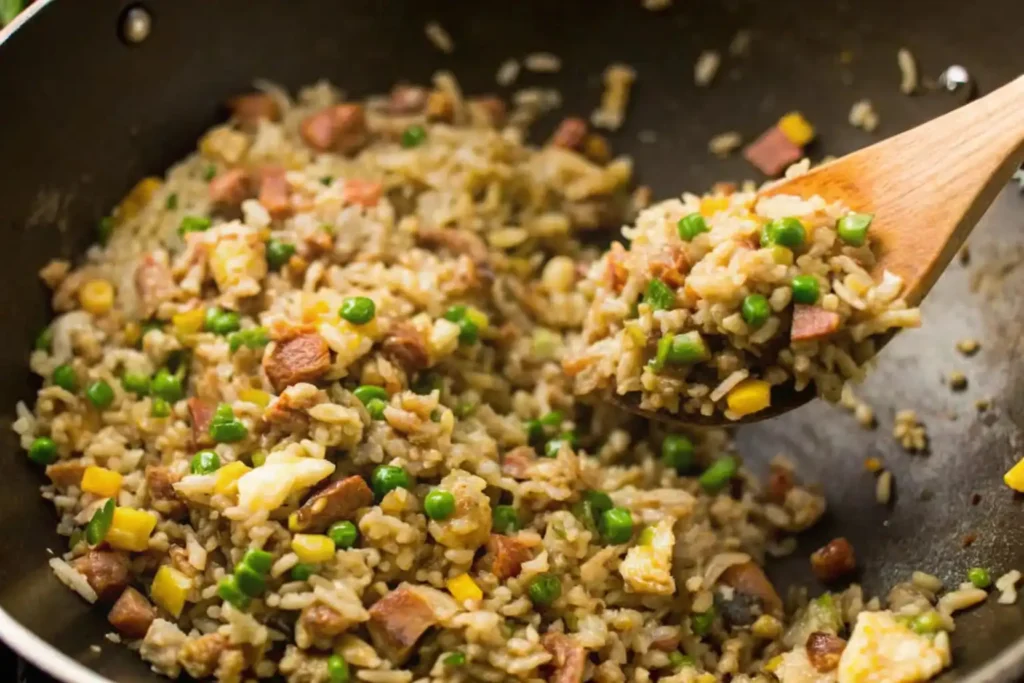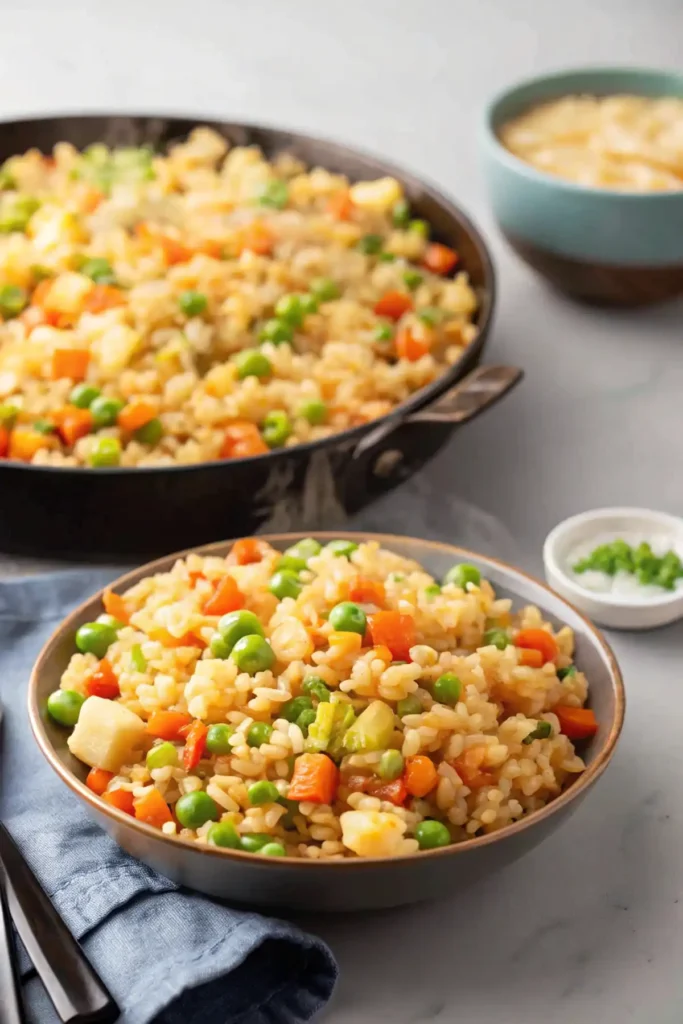Fried rice can be that magical dish, transforming plain, leftover rice into a rice dish so full of flavor and texture. It is versatile and easy to make. But when it comes to butter or olive oil, the battle gets a bit hotter in the kitchen. Each has its advocates, benefits, and of course, a unique vibe.
So, let’s dig deep (like spoon-straight-into-the-bowl deep) and figure out Is butter or olive oil better for fried rice?

The Role of Fat in Fried Rice
But before we start choosing sides, there’s the discussion of why fat has a role to play in fried rice. The fat you choose is not just meant to be “nonstick,” but also has a role to play in flavor. It helps caramelize the rice, enhances aromatics like garlic and onions, and ties all the ingredients together. Whether you’re whipping up a classic egg fried rice or something more experimental, the type of fat you use can make or break the dish.
Why Butter Shines in Fried Rice

Butter is the go-to for many fried rice lovers, and honestly, it’s easy to see why. It’s rich, savory, and just a little indulgent. If you’ve ever sat at a Japanese hibachi grill, you know exactly what I’m talking about—there’s nothing quite like that buttery aroma wafting through the air as your rice gets tossed and fried to perfection.
The Flavor Profile
Butter brings a rich round flavor that tastes almost similar to nuts with a hint of savory for fried rice. Frying the rice in butter makes it almost silky and shines with a characteristic golden-brown finish that’s very difficult to resist. The wonderful thing about the combination is that it goes along with soy sauce, garlic, and any other signature fried rice flavor without overshadowing them but rather enhancing their flavors.
The Texture
Butter gives fried rice a bit of stickiness, which can be a good thing if you’re looking for those crispy, golden patches of rice at the bottom of the pan. It doesn’t make the rice soggy—it just adds a little richness that takes each bite to the next level.
The Aroma
Butter smells amazing when it’s cooking. The moment it hits a hot pan, it releases a mouthwatering, toasty aroma that screams comfort food. If you’re cooking fried rice as a family dinner or a late-night snack, butter adds a cozy, home-cooked feel to the dish.
When to Use Butter for Fried Rice

- Japanese-Style Fried Rice: Butter is a must for hibachi-style fried rice.
- Rich, Indulgent Flavors: If you’re making fried rice as a main dish and want it to feel hearty, butter is your best friend.
- Classic Pairings: Butter works perfectly with eggs, chicken, shrimp, and vegetables like carrots and peas.
Olive Oil: The Healthier Contender
Now let’s discuss olive oil: an option that’s both lighter on your heart and just as versatile as butter. Olive oil offers great nutrition without compromising flavor – perfect if you want to stay healthier without giving up flavor altogether.
The Flavor Profile
Olive oil has a mild, slightly fruity taste that complements fried rice without stealing the spotlight. It’s especially good if you’re adding bright, fresh ingredients like scallions, bell peppers, or cilantro. Plus, if you’re going for a fusion-style fried rice with Mediterranean or Middle Eastern influences, olive oil fits right in.
The Smoke Point
Here’s a technical win for olive oil: it has a higher smoke point than butter. This means it can handle the high heat required to fry rice without breaking down or burning. (Burnt oil = bitter taste, and nobody wants that.)
Health Benefits
Unlike butter, olive oil is rich in monounsaturated fats, which are good for your heart. It also has antioxidants that can reduce inflammation and protect against certain chronic diseases. So if you’re cooking for health-conscious eaters—or yourself on a good day—olive oil is a smart pick.
When to Use Olive Oil for Fried Rice
- Light, Fresh Flavors: Olive oil pairs beautifully with vegetables, seafood, or citrusy seasonings.
- Healthier Meals: If you’re cutting back on saturated fats, olive oil is the way to go.
- Fusion Dishes: Think Mediterranean-inspired fried rice with olives, feta, or herbs.
The Case for Combining Butter and Olive Oil
There’s good news: you don’t have to pick just one or the other; in fact, mixing butter and olive oil provides you the best of both worlds. Start with olive oil to sauté your garlic, onions, and other aromatics. The higher smoke point will prevent burning while creating a flavorful base. Then, finish with a pat of butter to include richness and a silky texture to the rice. It’s a match made in culinary heaven.
The Cultural Influence on Fat Choices in Fried Rice
The decision between butter and olive oil can also depend on the cultural style of fried rice you’re preparing. For example, Japanese fried rice often incorporates butter because it aligns with the creamy, umami-rich flavors commonly found in hibachi-style dishes. Meanwhile, in Chinese fried rice, neutral oils like vegetable or peanut oil are traditional, but olive oil can be a modern, healthier substitute. Adapting the fat to the recipe’s cultural origins can add an extra layer of authenticity and flavor to your dish.
Can You Add Other Fats to Fried Rice?
While butter and olive oil are excellent options, they’re not the only fats you can use. For instance, sesame oil is a popular choice in Asian cooking, often added at the end of cooking for its strong, nutty aroma. Coconut oil can bring a tropical twist, especially if you’re making fried rice with pineapple or shrimp. Even bacon fat or lard can be used for an ultra-savory flavor, making your fried rice taste richer and more indulgent.
Pairing Butter or Olive Oil with Proteins
The type of fat you use can also complement the protein in your fried rice. Butter works beautifully with proteins like shrimp, chicken, or eggs, as it enhances their natural sweetness and adds a silky texture. On the other hand, olive oil pairs well with leaner proteins like tofu or fish, keeping the overall flavor light and fresh. Experimenting with different fats and proteins can help you create a fried rice dish that’s perfectly tailored to your taste.
Health Considerations and Alternatives
If health is a priority, choosing the right fat for fried rice is key. While olive oil is widely known for its heart-health benefits, you can also opt for ghee (clarified butter) for a slightly healthier version of the buttery flavor. Ghee has a higher smoke point than regular butter and is lactose-free, making it suitable for people with sensitivities. Pairing healthier fats with brown rice or quinoa instead of white rice can further increase the nutritional value of your fried rice.
Cooking tricks for Avoiding Sticking or Sogginess
No matter which fat you choose, how you use it is just as important. Always heat the fat before adding the rice—this prevents sticking and ensures the grains fry evenly. If using butter, avoid high heat to prevent burning, and if using olive oil, choose light or extra light varieties for frying. Proper technique combined with the right fat ensures that your fried rice turns out crispy and flavorful every time.
Pro Tips for Next-Level Fried Rice
- Use Day-Old Rice: Fresh rice is too sticky for frying. Day-old rice is drier and separates easily, which helps it crisp up.
- Cook in Batches: Overcrowding the pan can make your rice soggy. If you’re making a large batch, cook in two or three rounds.
- Don’t Skimp on Heat: High heat is crucial for that smoky, slightly charred flavor that makes fried rice so addictive.
The Smoke Point Factor in Fried Rice
When deciding between butter and olive oil for fried rice, understanding the smoke point is crucial. Butter has a lower smoke point, meaning it can catch fire quickly when subject to too much heat in a pan. This can leave your fried rice with a bitter taste if you’re not careful. Olive oil, especially light or extra light varieties, has a higher smoke point and can handle the high heat required for frying. This makes olive oil more reliable if you’re cooking on high heat and aiming for that perfect crispy texture.
The Role of Aromatics with Butter and Olive Oil
Your choice of fat will also have an effect on how your aromatics infuse flavor into your dish. Butter adds sweetness while olive oil provides more of a neutral base which lets bold spices like cumin or chili stand out more prominently. Pairing the right fat with seasonings can elevate the overall flavor profile of fried rice dishes.
Fried Rice: A Seasonal Comfort with Friends
Fried rice is more than just a dish; it’s an experience, especially when shared among friends in any season. In winter months, buttery fried rice offers comforting warmth with its indulgent flavors and is the ideal comfort food. Imagine spending an evening together serving steaming fried rice while the aromas of butter, soy sauce and garlic fill your house–an unforgettable winter night awaits you. Combine that experience with movie watching for the ultimate winter evening.
Olive oil shines brightest during summertime, giving fried rice its signature fresh, light taste. Combine seasonal veggies like zucchini, bell peppers or sweet corn for an ideal picnic-friendly dish and pair it with chilled drinks on the patio for an evening filled with good times and happy memories.
Fried rice is always a crowd-pleaser and brings people together, whether for casual dining with friends or as an unexpected potluck dish. No matter the season or event, its hearty flavors bring people together – what could possibly beat sharing great food with those closest to us?
FAQs
Is fried rice better with butter or oil?
It depends on your taste preferences. Butter adds a rich, creamy flavor that works well for hibachi-style fried rice, while oil, like olive or sesame, gives a lighter and more versatile base. Both are great options, so it’s up to the vibe you’re going for!
Which oil is best for fried rice?
Light oils with high smoke points, like vegetable oil, canola oil, or sesame oil, are ideal for fried rice. If you prefer a healthier option, light olive oil works well without overpowering the dish.
Is it better to put butter or oil in rice?
Butter is better if you want a richer, more flavorful result, especially for plain steamed or fried rice. Oil is better if you’re aiming for a lighter texture or need a neutral cooking base.
Is it better to fry in oil or butter?
For frying, oil is typically better due to its higher smoke point, which allows for higher heat without burning. However, butter can be added at the end for flavor if you want the best of both worlds.
Final Thoughts: Is butter or olive oil better for fried rice?
So, is butter or olive oil better for fried rice? Well, it’s really about what flavor fits your palate and what you are making. Butter gives fried rice the real nice homey flavor for the purest of fried rice. Olive oil makes fried rice easy on the palate, and it is also healthy for the heart. But why not try both? Join the two and treat yourself with the best from both worlds.
You are actually the winner at the end of the day because be it one fat or the other, you would complete the plate up with fried rice-deliciousness. Go ahead and grab your pan, and get cooking. You are only a few minutes away from a perfect fried rice!



1 thought on “Is butter or olive oil better for fried rice?”